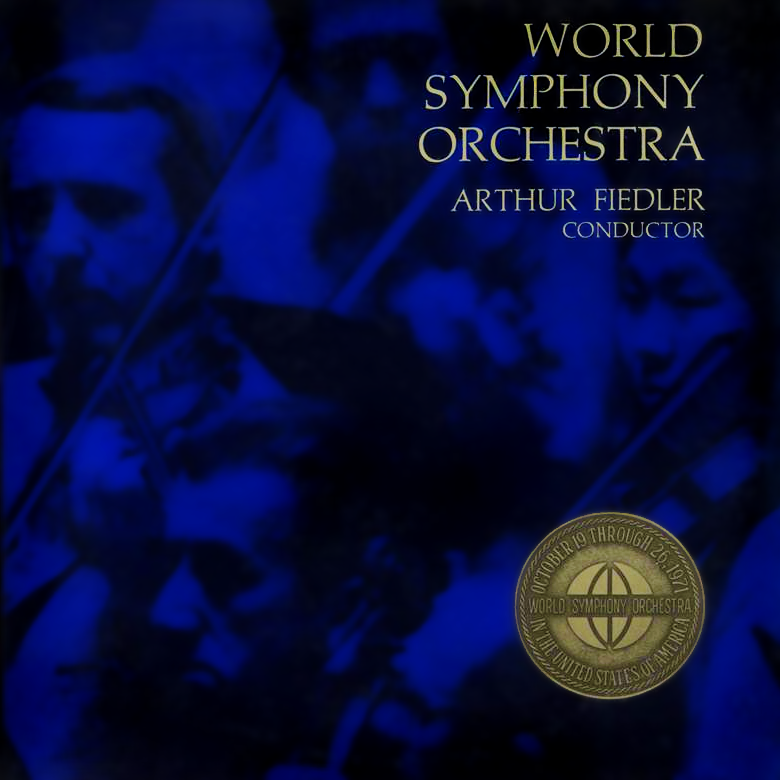
Gala Dedication Concert
Gala Dedication Concert
Part of the 3-day Grand Opening ceremonies of Walt Disney World. This Gala Dedication Concert was performed by the “World Symphony Orchestra” which consisted of 145 musicians from 63 nations and over 30 states.
↓ ↓ Look below the playlist for the full history. ↓ ↓
-
3:07Aaron Copland
-
6:20Dmitri Shostakovich
-
16:24Wilhelm Richard Wagner
-
21:08Ottorino Respighi
-
4:10Alberto Ginastera
-
12:08Jacques Offenbach
-
4:02Johann Sebastian Bach
-
0:16Jack Wagner
-
4:30Richard Sherman
-
0:15Jack Wagner
-
3:38John Philip Sousa

Liner Notes
MUSICAL PROGRAM
COPLAND
Fanfare for the Common Man
It is said of Copland that he dipped his hands into the American experience and turned it into sound. His message is a universal call for harmony.
SHOSTAKOVICH
Festive Overture, Op. 96
The celebration of life is known to every nationality and is expressed here with a rich orchestral palette proclaiming man at his robust and exuberant best.
WAGNER
Prelude and Love-Death, from "Tristan and Isolde"
The power of love and the fate of man is sealed in the Tristan and Isolde legend. Tristan and Isolde's avowal of love obliterates all else of value in the world. Death seems to be their only deliverance.
RESPIGHI
"Pines of Rome," Symphonic Poem
Respighi composed three pieces interpreting aspects of the Eternal City-fountains, pines, and festival — all of which vividly mirror the interplay of nature and man's memories. The four connected sections of the Pines are described in a preface to the score:
I. The Pines of the Villa Borghese.
Children are at play in the pine grove of the Villa Borghese, dancing the Italian equivalent of "Ring Around a Rosy"; mimicking marching soldiers and battles; twittering and shrieking like swallows at evening; they disappear. Suddenly the scene changes to —
II. Pines near a Catacomb.
We see the shadows of the pines, which overhang the entrance of a catacomb. From the depths rises a chant which reechoes solemnly, like a hymn and is then mysteriously silenced.
III. The Pines of the Janiculum.
There is a thrill in the air. The full moon reveals the profile of the pines of Gianicolo's Hill. A nightingale sings.
IV. The Pines of the Appian Way.
Misty dawn on the Appian Way. The tragic country is guarded by solitary pines. Indistinctly, incessantly the rhythm of innumerable steps. To the poet's phantasy appears a vision of past glories blare, and the army of the Consul advances brilliantly in the grandeur of a newly risen sun toward the Sacred Way, mounting in triumph the Capitoline Hill.
GINASTERA
Final Dance (Malambo), from "Estancia"
The struggle and triumph of the human will over physical force is the underlying theme of this ballet set on an Argentine ranch. In an intense dance tournament, called the Malambo, a city boy competes with a gaucho (cowboy), winning the day.
OFFENBACH
Suite from "Gaite Parisienne"
Overture — Allegro brillante — Galop
Valse — March — Can-Can — Finale
The playful quality in man can be seen in every culture and dance is one of its manifestations. Offenbach preserves here, for the world to steal yet another look at, the lure of the can-can kicked at top speed.
BACH
Fugue in G Minor ("The Little")
Hindemith said of Bach that he attained all that is humanly possible. "He stands, as the old Persian poem says, before the curtain that nobody will ever draw aside." The vitality and brilliance of Bach's craft is amply demonstrated in this brief work.
SHERMAN
It's A Small World
This special encore commemorates the grand opening of Walt Disney World and salutes international brotherhood.
SOUSA
The Stars and Stripes Forever
The final encore expresses gratitude to the people of the United States of America for hosting the first World Symphony Orchestra.
Arthur Fiedler, Conductor
Serving as conductor of the World Symphony Orchestra is the distinguished American-born maestro, Arthur Fiedler. Few conductors could serve the idea of the World Symphony Orchestra as well. For over half a century Mr. Fiedler has mounted the podiums of the world to bring to people everywhere the message of music as a language of friendship and understanding. It is safe to say that he has been audience than any other conductor. He is indefatigable in his efforts to share his own enjoyment of music with people everywhere, and his appearance with the World Symphony Orchestra is a testament to his belief in the universality of musical communication.
The World Symphony Orchestra Story
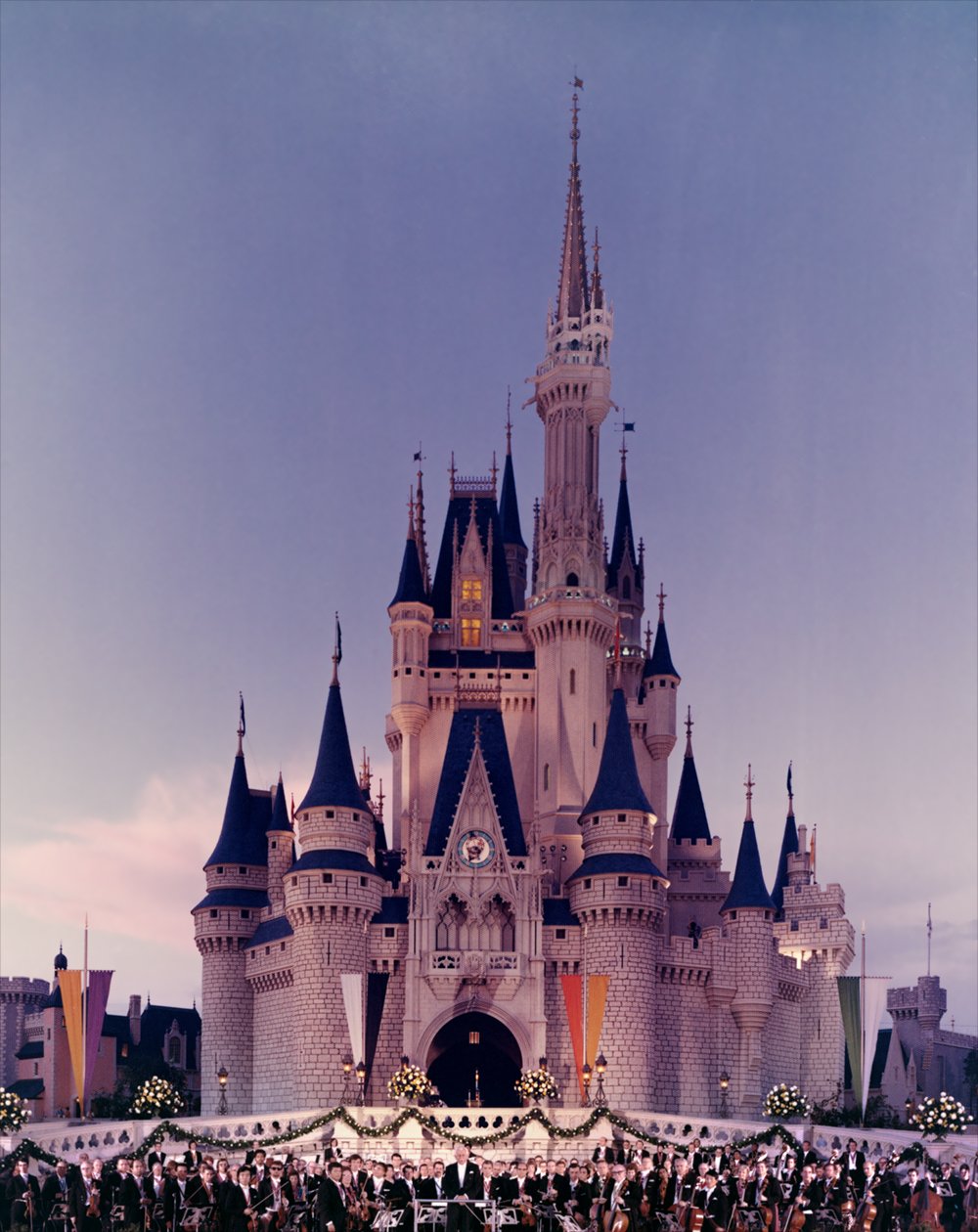
The commonality of people and nations is a theme often championed but seldom demonstrated. How is it possible to bring the human family together comp flower now is together even for a brief time and communicate the basic solidarity that underscores the "human" designate?
The World Symphony Orchestra was born to answer such a question. Its one-week existence, October 19 through 26, 1971, brought together 142 distinguished musicians from more than sixty nations and thirty states. This first professional world orchestra was a monument to international understanding. Through music, it symbolized the natural convergence of people and their basic similarity.
The World Symphony Orchestra, an invention of Walt Disney Productions' "Imagineers," was sponsored by the Federation of People-to-People Programs, and attracted the broad support of private citizens professional organizations, private corporations, and the United States Department of State. Collectively their efforts and generosity permitted a worthy idea to turn into a stunning reality.
For four months a small staff worked round the clock in the People-to-People offices in Washington, D. C. to organize the huge undertaking. The State Department issued the invitations to foreign musicians through the American embassies around the world. Domestic invitations were extended with the assistance of the American Symphony Orchestra League. The widest possible participation was sought. Each professional musician was to serve as a "Musical Ambassador" representing, through his own artistry, the musical traditions of his own orchestra, city, and country.
A conductor was chosen: Maestro Arthur Fiedler of Boston Pops fame. An expert conductor, he was well-known the world over, spoke five languages, and had the personal magnetism that the project seemed to require. (It turned out that he had guest-conducted fifty-five of the more than one-hundred orchestras represented in the ensemble.) The musical programming, staging, and equipment needs began to be worked out.
Plans for the symphony's week in the United States started to take shape. There would be three concerts, the first at New York's Philharmonic Hall at Lincoln Center for the Performing Arts as part of the annual United Nations Week celebration; the second for the gala dedicatory opening of Walt Disney World in Orlando, Florida; and the final in the Opera House of the John F. Kennedy Center for the Performing Arts in Washington, D. C.
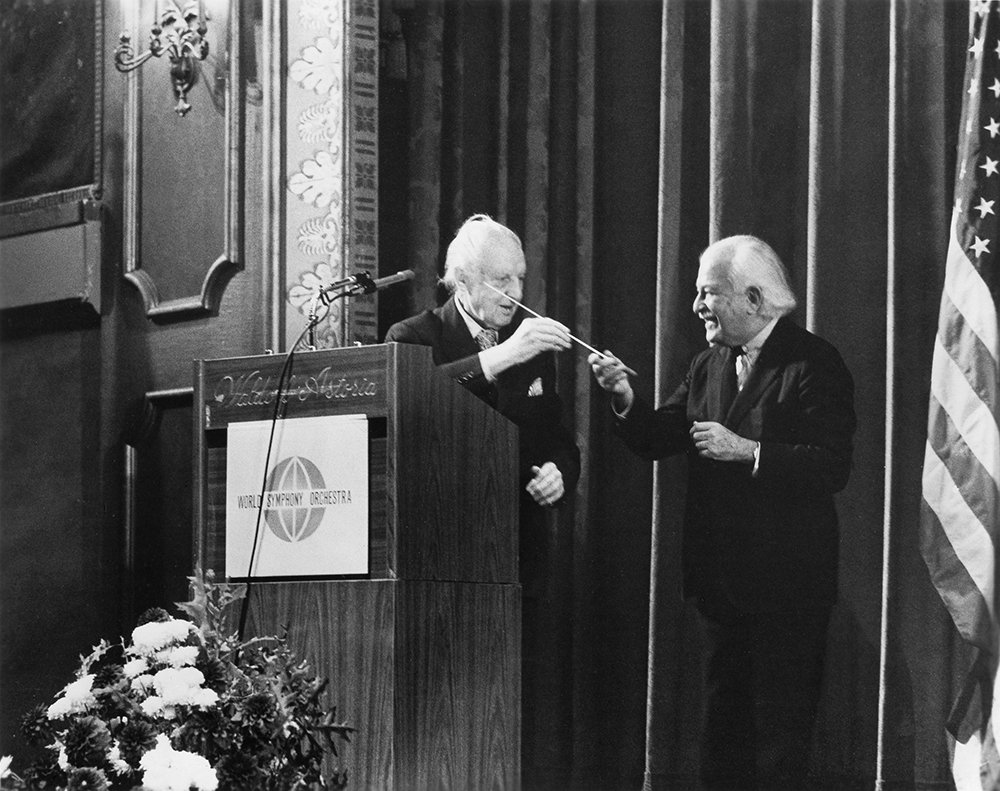
Leopold Stokowski presents the baton of the World Symphony Orchestra to Arthur Fiedler at the first breakfast-meeting of the orchestra in the Waldorf Astoria Ballroom. "Here is the wood," he said, "that gives wisdom to musicians."
Each musician was to be flown, first-class, to New York City where the orchestra would assemble, rehearse, and premiere. Pan American World Airways began arranging the foreign flight schedules, Eastern Airlines, the domestic. Cellists would be accommodated with an adjoining seat for their instruments. Each member of the orchestra was to be met by an official from the State Department and greeted by a member of the World Symphony Orchestra Hospitality Committee and escorted to the Waldorf Astoria Hotel, headquarters for the orchestra in New York. Translators were to be on hand to greet each foreign player.
Every one of a thousand details were given careful consideration. Rehearsals were scheduled at Carnegie Hall and on the Great Stage of Radio City Music Hall. It was agreed that the musical program should represent orchestral literature from different countries and eras. Press releases were written; information packets, assembled and distributed. A press conference was planned. Arrangements were made for a film documentary which would be created for broadcast, nationwide, on Thanksgiving evening, November 25, 1971. Plans were completed for the Musical Ambassadors to tour the nation's capital and to visit the White House.
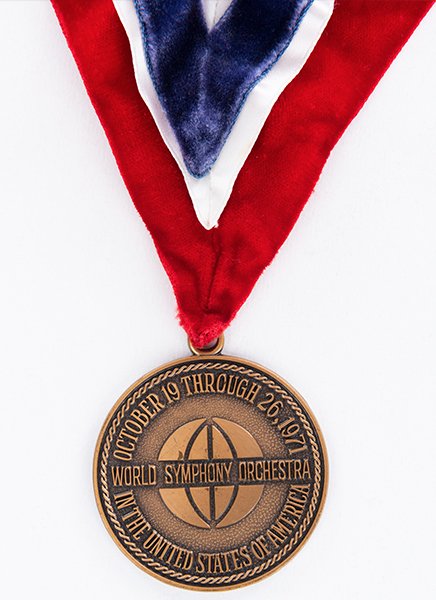
A limited edition of bronze medallions commemorating the first World Symphony Orchestra were designed and cast. They would be worn at each performance suspended by neck ribbons created in the colors of each participating nation. The musical program was set to include Copland, Shostakovich, Wagner, Respighi, Ginastera, and Offenbach. Agreements were drawn up with the American Federation of Musicians. Hal C. Davis, President of the A.F.M. lent his wholehearted encouragement and assistance. "The American Federation of Musicians," he said, "wishes to express to all those concerned with the organizing, support, and participation in the World Symphony Orchestra its endorsement of this worthy undertaking. The domestic endorsement of this project reflects and promotes the understanding and communication in the international community of music, which the A.F.M. has always held to be of great importance."
Information about passports and visas, weather and clothing, hotel addresses, and other necessary data was obtained, printed in booklet form, and mailed to each musician. The orchestra was carefully balanced with additional invitations to American symphony musicians. Arrangements for all meals were completed. Greyhound Lines offered to supply all ground transportation. Receptions were scheduled, including one at the State Department. There would be a champagne reception for the entire audience in Washington, D.C. to be held in the Atrium of the Kennedy Center following the final concert. A barrage of fireworks over the Potomac River would cap the evening and the week.
Finally, it was all happening. A fleet of limousines was chauffeuring the musicians one by one as they arrived at LaGuardia, Kennedy, and Newark Airports. Trucks were collecting luggage and instruments. In a matter of hours, every member of the orchestra was in New York.
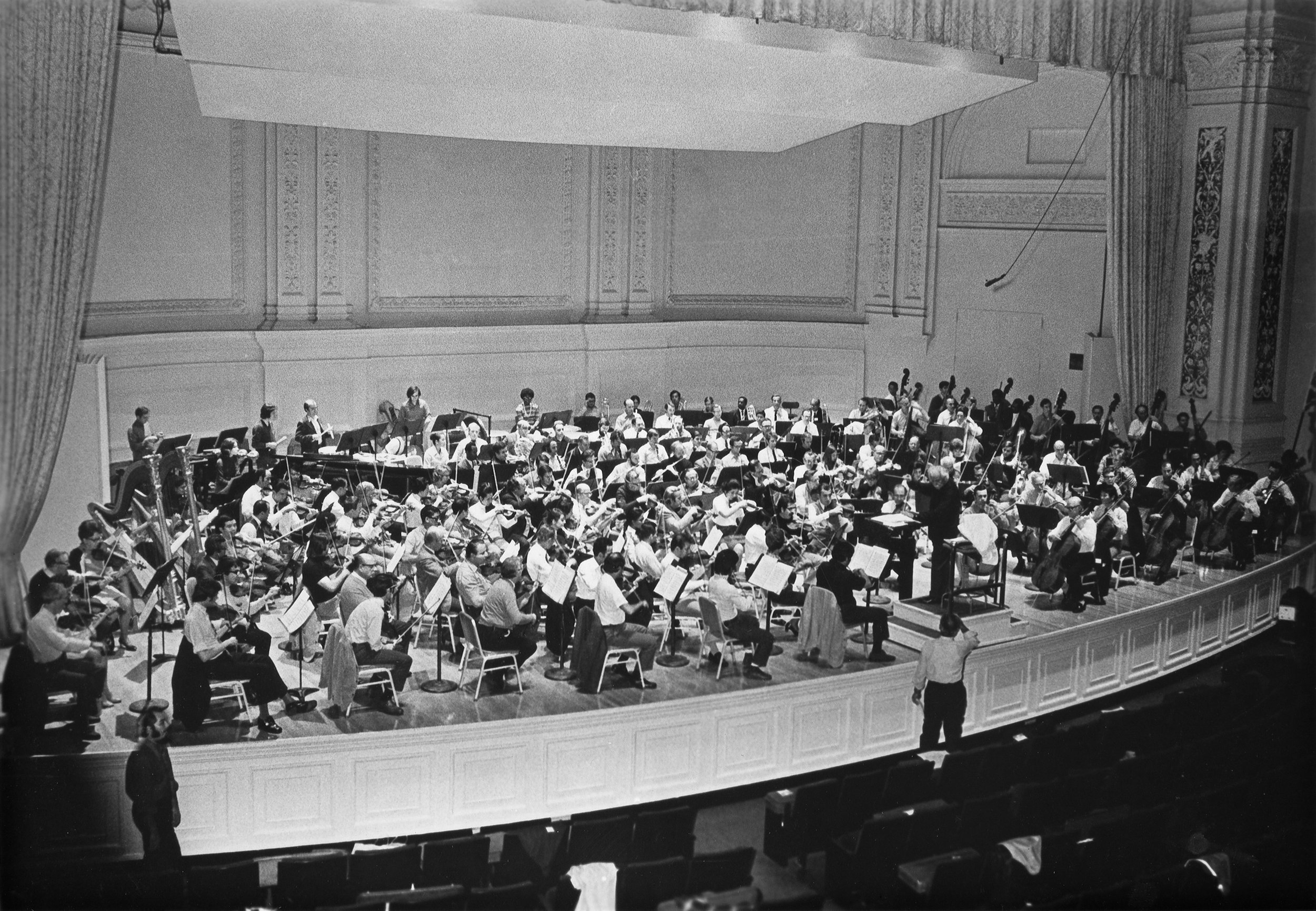
The 142 members of the World Symphony Orchestra rehearse together for the first time in New York City's renowned Carnegie Hall.
All one-hundred and forty-two Ambassadors were on hand at the opening breakfast in the Ballroom of the Waldorf Astoria at 8:30 a.m. on October 20, 1971. Each musician was personally introduced. All were presented with the World Symphony Orchestra medallion with their country's ribbons. The Honorable John Richardson, Jr., Assistant Secretary of State for Educational and Cultural Affairs, greeted members of the orchestra on behalf of the United States.
The musicians rose in instant recognition as the special surprise guest, Leopold Stokowski, entered the Ballroom. The ninety-year-old conductor spoke eloquently: "What an extraordinary occasion. We've all dreamed of world unity. At last, through your plans, we can see it as a reality. There is in my thoughts just one sad note, and that is: I wish Walt Disney could be here today. He was a wonderful personality, a man who recognized the beauty and creative power in everyone. Unfortunately, he has left us, but in my thoughts and heart he is with us in this great idea of a world orchestra-that through music we can find peace between nations instead of the cruel wars that exist at this moment." He then presented the baton of the World Symphony Orchestra to Arthur Fiedler.
Maestro Fiedler responded in kind: "The World Symphony Orchestra," he said, "is a wonderful adventure in international goodwill, which has great symbolic significance. There is a shared concern among people everywhere for a world at peace, and I believe that is the reason why so many people have been excited by the concept of a World Symphony Orchestra. Nothing can better express the common bond among all mankind than the universal appeal and inspiration of symphonic music. It is my hope that these 'musical ambassadors,' representing virtually every point on the globe, will exemplify the solidarity and affection that is possible among the peoples of the world."
The first rehearsal was electric. The musicians themselves were moved by the experience. In part, they were awed to think that all over the world people learn how to play the same music on the same instruments with the same technique. They were also caught up in the humanitarian spirit which flowed through the group. "We're playing not as professionals, but for the sheer love of it," was the way one of the musicians explained it. And they were. Musicians from Argentina and Portland, Iceland and Louisville, Singapore and Los Angeles, Wales and Boston, Egypt and Seattle, Finland and Denver, Thailand and Rochester, Hungary and Philadelphia, India and Cincinnati, Poland and San Francisco, Romania and Brooklyn, Israel and Pittsburgh, and more than a hundred other places were playing together like a world in concert. Just eighteen hours of rehearsal preceded the first performance.
The audience in New York consisted of ambassadors and officials of the United Nations Secretariat. Many of the dignitaries wore their national dress. The house lights dimmed. "Ladies and Gentlemen, the World Symphony Orchestra." As the musicians entered from either side of the stage, each was introduced by name and by country or state.
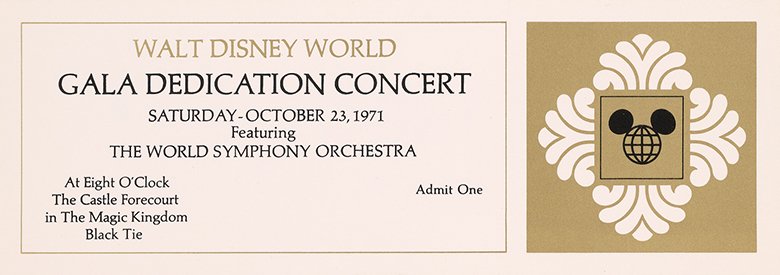
As these recordings will confirm, the concert communicated the orchestra's intent. Musicians from the four corners of the earth had melded themselves in unanimous accord. The press following the first concert noted the achievement. Miles Kastendieck, music critic for the Christian Science Monitor, wrote: "Symbolizing the harmony that could prevail among the peoples of the world, some 140 musicians achieved that aim musically at the debut of the World Symphony Orchestra in Philharmonic Hall, October 22. Sparked by Arthur Fiedler, the master conductor for this occasion, they achieved such an impressive ensemble of sonorities that everybody came out of the concert smiling. Not only had the idea worked, but experiencing the result was exhilarating."
Raymond Ericson wrote in The New York Times: "The sound of the orchestra, which was much larger than the standard 100-piece symphonic ensemble, had a marvelous sonority. The playing was disciplined and enthusiastic." He went on to say that, "It seemed almost a pity that the orchestra has to disband after three performances . . ."
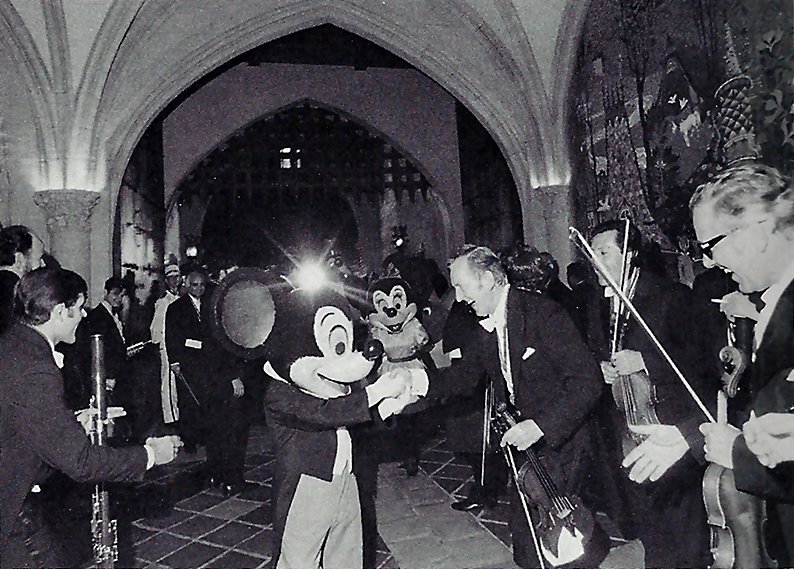
Mickey & Minnie Mouse greet members of the orchestra in Cinderella Castle prior to the concert.
Byron Belt, music critic for the Newhouse Newspapers, also praised the ensemble: "The World Symphony Orchestra," he observed, "was a dramatic gesture that proved to be an artistic triumph as well."
The chartered flight from New York to Orlando, Florida was arranged as a celebration with everyone enjoying champagne and filet mignon. The maestro was in good spirits. "We have an orchestra, and a very good one!" The home orchestras had selected their representatives well. There were eighteen concert masters in the first violin section, and sixty other players were principal or assistant principal players.
The concert setting in Florida was unique. The orchestra performed at dusk on the evening of October 23 in the forecourt of the eighteen-story Walt Disney World Castle. Prior to the concert the Disney family and Disney executives treated the musicians to dinner in the Medieval dining rooms within the Castle. Madrigal singers wandered among the tables singing Byrd, Morley, and Wilke. An invitational audience of 2500, which included many personalities of the entertainment world, the Governor of Florida, and numerous other notables, gathered on the paths among the flower gardens.
Conductor Arthur Fiedler
The concert setting in Florida was unique. The orchestra performed at dusk on the evening of October 23 in the forecourt of the eighteen-story Walt Disney World Castle. Prior to the concert the Disney family and Disney executives treated the musicians to dinner in the Medieval dining rooms within the Castle. Madrigal singers wandered among the tables singing Byrd, Morley, and Wilke. An invitational audience of 2500, which included many personalities of the entertainment world, the Governor of Florida, and numerous other notables, gathered on the paths among the flower gardens.
The program for the concerts contained a special tribute: "To Walt Disney, a true citizen of the world, who embellished the lives of people everywhere by devoting his life-long creative energy to building a world of happiness and the dream of its attainability."
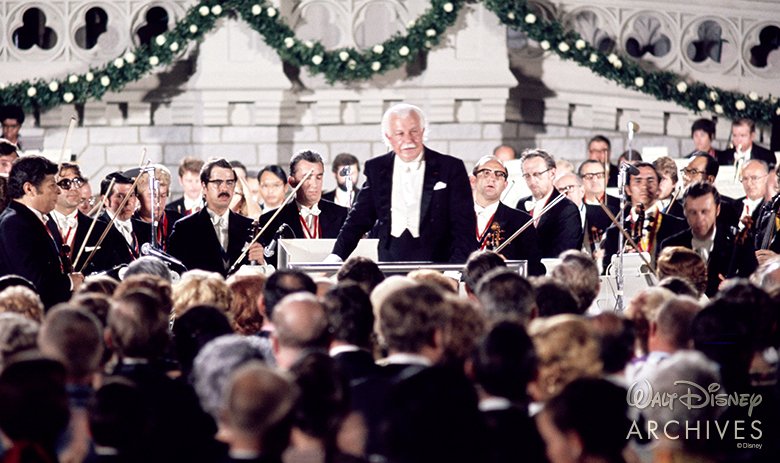
Following the concert, Roy Disney presented a bronze plaque commemorating this concert by the first World Symphony Orchestra, to be permanently affixed in the castle forecourt on the spot marking the position of the podium. The plaque reads: "On this site the World Symphony Orchestra, under the direction of Arthur Fiedler, performed a gala dedication concert in tribute to Walt Disney on the occasion of the grand opening of Walt Disney World, October 23, 1971." "This concert," Roy Disney said, "inaugurates a continuing series of festival programs in this new vacationland. These programs will host performing groups from around the world."
The final concert on October 25, in the red-silk-lined Opera House of the John F. Kennedy Memorial Center for the Performing Arts in Washington, D.C., was attended by international dignitaries, including officials from diplomatic missions in Washington, United States government officials, and a host of prominent businessmen from all parts of the United States.
President Richard M. Nixon gave tribute to the symphony:
"Throughout the ages music has provided communication among peoples otherwise separated by differences of nationality, culture, and language.
The mutual understanding found in this distinguished assemblage of musicians from the many countries represented in the World Symphony Orchestra gives cause for hope and expectation to all who value the importance of a widening pattern of people-to-people relationships. It is a source of continuing encouragement to all who are committed to the achievement of a true and lasting peace.
I extend my special appreciation to the many individuals and organizations from the United States and abroad who have joined their talents, energy and resources to give reality to this splendid tribute to harmony among men and nations."
In its 204 hours of existence, the World Symphony Orchestra had exemplified in spirit what brotherhood among peoples is all about. They had reminded everyone who heard them of mankind's shared concern and hope for a world at peace. That thought is projected through the sounds preserved on these recordings.
WSO Rehearsal
The Committee for the
World Symphony Orchestra
A project as comprehensive and global as the World Symphony Orchestra required equivalent broad support to assure not only it’s coming to life but its success. The World Symphony Orchestra Committee was composed of private citizens, professional organizations, and private corporations whose cooperative generosity supported this endeavor.
Mrs. Dwight David Eisenhower, Honorary Chairman
Mr. John P. Fraim, Chairman
THE FEDERATION OF
PEOPLE-TO-PEOPLE PROGRAMS, INC.
Dr. William B. Walsh, Vice Chairman;
President and Chief Medical Advisor, Project Hope
THE UNITED NATIONS ASSOCIATION
OF THE UNITED STATES OF AMERICA
The Honorable Earl Warren, Chairman of the Association
Mr. Robert S. Benjamin, Chairman, Board of Governors
Mr. Porter Mckeever, President
THE AMERICAN FEDERATION OF MUSICIANS
Mr. Hal C. Davis, President
THE JOHN F. KENNEDY CENTER
FOR THE PERFORMING ARTS
Mr. Roger L. Stevens, Chairman of the Board of Trustees
WALT DISNEY PRODUCTIONS
Mr. Roy O. Disney, Chairman of the Board
Mr. Donn B. Tatum, President
Mr. E. Cardon Walker, Executive Vice President
PAN AMERICAN WORLD AIRWAYS, INC.
Mr. Najeeb E. Halaby, President and Chief Executive Officer
Mr. James O. Leet, Group Vice President
EASTERN AIR LINES, INC.
Mr. Samuel L. Higginbottom, President
Mr. Thomas B. McFadden, Senior Vice President-Marketing
THE GREYHOUND LINES, INC
Mr. James L. Kerrigan, President
Mr. C. D. Kirkpatrick, Vice President-Passenger Sales
THE UNITED STATES STEEL CORPORATION
Mr. Edwin H. Gott, Chairman of the Board
The Committee gratefully acknowledges and
appreciates the assistance and support of:
THE UNITED STATES DEPARTMENT OF STATE
The Honorable John Richardson, Jr.,
Assistant Secretary for Educational and Cultural Affairs
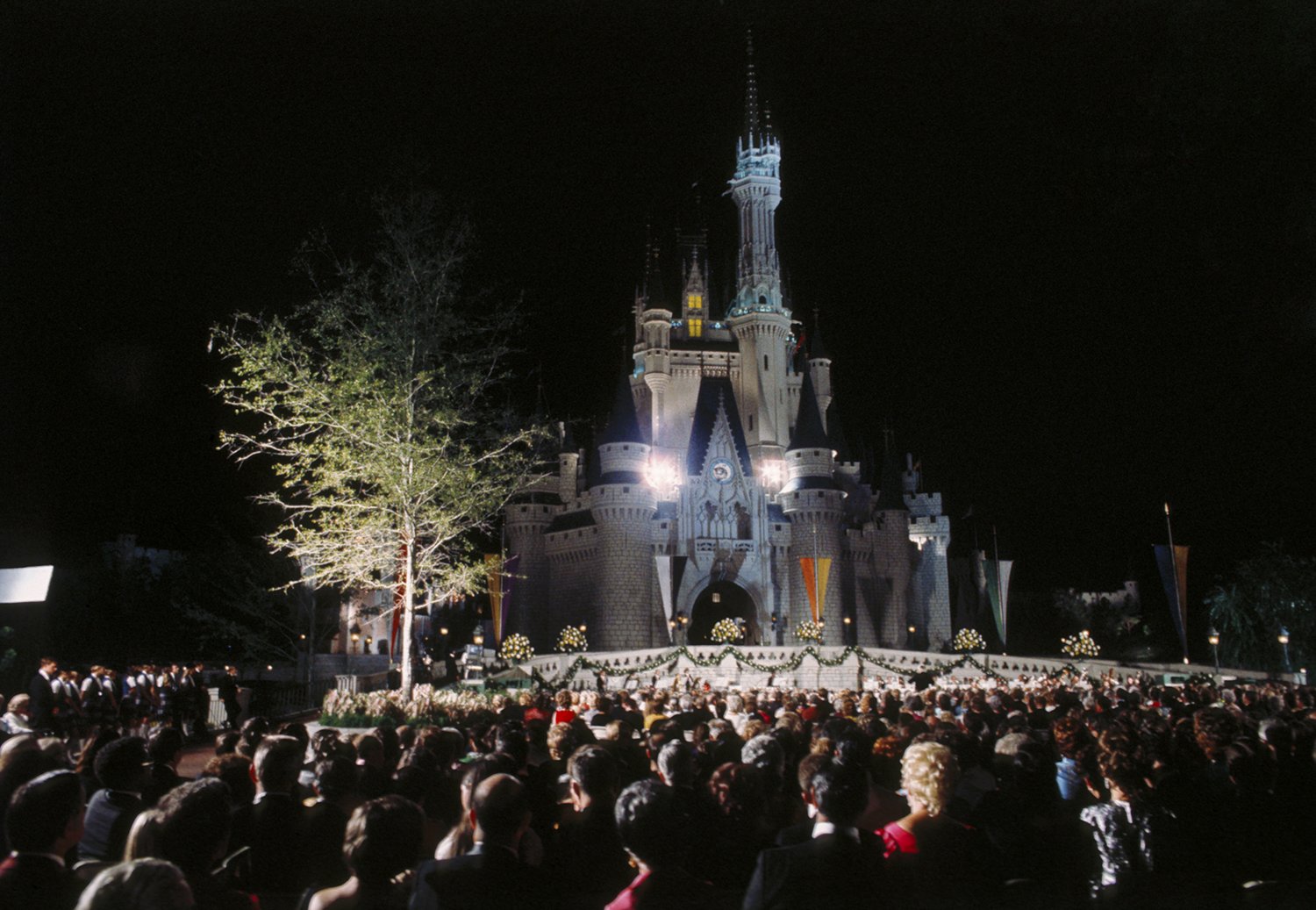
2022 Restoration
During the production of A Musical History of the Magic Kingdom I was faced with the rather daunting task of how to start that extensive journey through 50 years of the park’s repertoire that would convey a the gravitas of its history while also paying tribute to its historical beginning.
Enter the Gala Dedication Concert.
While looking through the research I was surprised to discover a recording of the concert was made on-site and preserved on LP. One of these stayed in its plastic wrap for literally half a century before it was procured by Vinyl Preservationist Todd Horan and promptly digitized.
Although in amazingly good condition with dynamic range, it was (like all LPs) in need of a considerable amount of care including the manual removal of several thousand pops and clicks and careful noise reduction to remove artifacts while retaining all the details.
Below the original cover is a sample of the record in its original condition before restoration.
